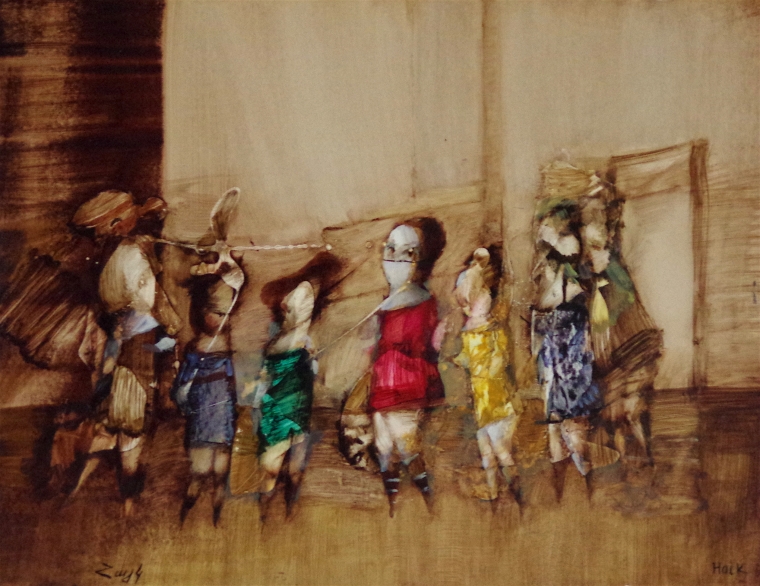The Duty of Feeling and Expression in Figurative Oil Painting: A Comprehensive Evaluation of Subject and Composition
The interplay of feeling and expression in metaphorical oil paint functions as an important lens through which one can take a look at the elaborate relationship between topic and composition. Artists harness various strategies, from shade choice to brushstroke characteristics, to cultivate psychological resonance within their works. This nuanced orchestration not just shapes viewer understanding yet additionally welcomes a much deeper questions right into exactly how these components coalesce to mirror the intricacies of human experience. As we discover this abundant surface, one need to consider exactly how specific case research studies illuminate the wider ramifications of these imaginative options.
Comprehending Emotion in Art
Emotion in art works as a powerful conduit for expression, allowing artists to convey intricate sensations through their job. In figurative oil painting, this psychological depth is frequently portrayed through the representation of the human number, recording the nuances of human experience. The option of subject issue, color combination, and brushwork all add to the emotional vibration of a piece.
Artists often bring into play individual experiences, social issues, or universal motifs to evoke feelings in the viewer. A portrait might mirror susceptability, while a vibrant number in movement can symbolize flexibility or turmoil. These psychological strings link the viewer to the artwork, promoting a discussion that goes beyond the visual medium.
In addition, the interaction between light and shadow can intensify emotional intensity, guiding the audience's look and drawing attention to particular components within the make-up. Making use of appearance in oil painting even more includes layers of complexity, welcoming a responsive feedback that improves the emotional experience. In general, comprehending feeling in art is essential for appreciating the subtleties that define metaphorical oil painting, as it changes plain depiction into a profound exploration of the human problem.
Crucial Element of Structure
In the realm of figurative oil painting, the make-up works as the underlying framework that organizes visual elements and boosts the psychological story. Important parts of make-up consist of balance, contrast, focal point, and rhythm, each adding to the overall effect of the artwork.
Balance refers to the circulation of aesthetic weight within the painting, which can be accomplished via in proportion or unbalanced setups. A well-balanced structure offers stability, allowing the customer to involve with the piece sympathetically - figurative oil painting. Comparison, on the other hand, entails juxtaposing different elements, such as dark and light or cozy and awesome shades, to guide the viewer's eye and evoke emotional feedbacks
The focal factor is essential, as it guides attention to the most significant component of the paint, frequently highlighting the emotional core of the story. By skillfully incorporating these key components, artists can craft engaging and psychologically resonant figurative oil paints that astound and engage their target market.
Topic and Its Influence
Topic plays a crucial function in figurative oil painting, as it not just serves as the foundation for the story however likewise shapes the visitor's interpretation and emotional engagement with the artwork. The selection of subject-- be it a solitary number, a team dynamic, or a thematic depiction-- straight affects the emotional environment communicated to the target market.

As an example, pictures usually stimulate personal links, revealing the intricacies of human expression and personality, while scenes showing communal tasks can create a sense of belonging or nostalgia. The social and historical context of the subject issue improves the visitor's understanding, prompting deeper representations on social norms, worths, and the human problem.
Various subjects also create varying degrees of interaction; a dramatic problem shown through figures in stress may elicit feelings of anxiety or compassion, while calm landscapes can invoke peace and contemplation. Eventually, the effect of subject matter in figurative oil painting is extensive, as it works as a channel for emotional resonance, assisting the audience's reaction and interpretation, and cultivating a link between the art work and the observer. This interplay is necessary for the successful communication of the musician's intent.
Techniques for Evoking Sensations
The effectiveness of metaphorical oil paint in conveying emotions is significantly influenced by the methods employed by the musician. One of one of the most crucial methods is making use of color theory, where the strategic choice of shades can evoke details psychological reactions. Warm colors, such as reds and oranges, usually generate sensations of interest or hostility, while cooler tones like blues and eco-friendlies have a tendency to evoke calmness or sadness.
One more important method is the manipulation of light and darkness, referred to as chiaroscuro. This technique enhances the three-dimensionality of numbers, developing remarkable contrasts that can magnify psychological deepness. The placement of light can lead visitors' emotions, highlighting specific elements of the structure.
Brushwork also plays a critical function; loose, meaningful strokes can share power and spontaneity, whereas smoother techniques may recommend serenity or accuracy. The arrangement of subjects within the structure can affect emotional impact. Close proximity can recommend affection, while range might show seclusion.
Inevitably, the mix of these methods enables my website musicians to craft narratives that reverberate with the customer, changing a mere aesthetic experience into an evocative emotional trip. - figurative oil painting

Study of Noteworthy Functions
Analyzing notable jobs of figurative oil painting reveals how numerous techniques are employed to stimulate effective feelings. One excellent situation is Edvard Munch's "The Scream," where the altered number and swirling history communicate existential fear. Munch's usage of color-- deep blues and vivid oranges-- increases the psychological impact, showcasing how combination choices can shape audience experience.
One more significant job is Pablo their explanation Picasso's "Les Demoiselles d'Avignon." Here, fragmented kinds and strong brushstrokes mirror a tumultuous psychological landscape, testing conventional depictions of the women number. Picasso's cutting-edge structure not just captures the audience's interest but also welcomes consideration on themes of identity and sexuality.
Additionally, Frida Kahlo's "The Two Fridas" supplies an emotional exploration of duality and self-identity. The different figures, connected by a common heart, exemplify Kahlo's psychological depth and personal story. figurative oil painting. Her meticulous attention to information and symbolic components serve to involve viewers on a visceral degree
These study underscore the extensive link between feeling and make-up in figurative oil painting, revealing how musicians harness method to connect complicated sensations and stories that reverberate throughout time and society.

Final Thought
In conclusion, the interaction of feeling and expression in metaphorical oil paint significantly boosts the audience's experience and analysis of the artwork. Via a mindful selection of topic and compositional strategies, musicians communicate profound narratives that resonate on both universal and personal degrees. The application of color theory, chiaroscuro, and brushwork more amplifies emotional deepness, transforming each canvas right into a powerful representation of the intricacies of the human experience.
In figurative oil paint, this psychological depth is usually depicted through the representation of the human number, capturing the nuances my response of human experience.Moreover, the interaction in between light and darkness can magnify psychological intensity, guiding the audience's gaze and drawing attention to particular components within the composition. The usage of structure in oil paint further adds layers of intricacy, inviting a tactile feedback that boosts the psychological experience.The focal point is critical, as it guides interest to the most significant component of the painting, frequently highlighting the emotional core of the narrative. Eventually, the effect of subject matter in metaphorical oil painting is extensive, as it offers as an avenue for emotional resonance, assisting the audience's reaction and analysis, and promoting a link between the artwork and the onlooker.